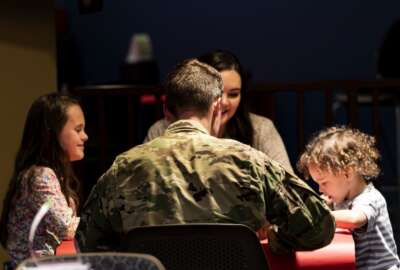For nearly a decade, the Army has not been able to hit its recruitment targets. 2024, however, could mark a turning point in the service’s recruitment efforts.
The Air Force missed its recruiting goals for the first time since 1999 last year. But Air Force officials are “cautiously optimistic” that the service is on track to hit its active duty and reserve recruitment targets.
The Navy, however, is projected to miss its goals by 6,700 recruits in 2024—marking the second year in a row the service will not be able to attract enough sailors.
And while 2024 is shaping up to be a better year for the services, this mixed recruitment picture highlights the complex and multifaceted challenges the military continues to face. A strong labor market, general lack of awareness about military service, restricted access to schools in the post-pandemic world and growing distrust in public institutions have “turned into a perfect storm,” Alex Wagner, Air Force personnel boss, said in December.
The Army wants to bring in 55,000 new recruits by the end of 2024. Army Secretary Christine Wormuth said she is “feeling a lot better” about recruiting this year.
“I don’t want to be overconfident but I think we feel that we have a good shot at making that goal this year,” Wormuth told lawmakers during a congressional hearing on Tuesday.
Wormuth said the service is doing better this year partly due to the success of its future soldier prep course, a program that helps new recruits meet military standards and go into basic training. Since 2022, the program has graduated about 18,000 soldiers with a 95% success rate.
“There’s an academic track for young people who haven’t quite scored high enough on the test that we use. And then there’s a physical track if you’re not quite within the body fat standards – young people can take one or the other. We now have expanded it and they can take them in parallel. They often are going into basic training and taking on leadership roles in basic training. So it’s been very successful so far,” Wormuth told lawmakers during the Senate Armed Services Committee hearing Thursday.
The service is now conducting a study that tracks future soldier prep course graduates as they transition to their first duty station and receive their first assignments to see how they perform.
The Army is also transforming the way it runs its recruitment offices. The service is in the middle of standing up an innovation directorate that will be part of the Army Recruiting Command.
The new unit will help develop a pipeline of specialized recruiters and integrate artificial intelligence and machine learning technologies into recruitment.
“They’re helping us look at what we would call the recruiting station of the future. We really think we need to fundamentally relook everything from the storefronts to how our recruiting stations operate,” said Wormuth.
Still, the Army set a lower goal for itself this year. In 2023, the goal was to bring in 65,000 new soldiers. Earlier this year, the service decided to bring down its authorized troop levels to 470,000 soldiers by 2029 from 494,000 soldiers due to its transition from counterinsurgency missions to large-scale combat operations.
The Air Force is also projected to meet its recruiting goals this year. The service wants to bring in 26,000 active duty airmen this year. In response to a decline in retention rates this year, the service recently increased its recruiting goal by 1,200.
“We’re actually doing very well this year. The Air Force is on track at this point to essentially meet its goals. In fact, we’re looking at revising the goals up slightly. The Reserves are doing well. Also, the Guard has improved their performance over last year, but it’s not quite meeting their targets,” Air Force Secretary Frank Kendall told lawmakers last week.
Lt. Gen. Caroline Miller, Air Force deputy chief of staff for manpower, personnel and services, told lawmakers they are “cautiously optimistic we will meet fiscal 2024 recruiting goals due to modification of our policies.” The service adjusted its internal requirements, including its tattoo policies, body composition and drug testing requirements. Additionally, to expand its recruitment pool, the service now allows legal permanent residents to enlist.
At the same time, the Navy is “aggressively pursuing” 40,600 new recruits this year but will most likely miss the goal.
“We continue to face challenges in the current and forecasted economic environment and tough labor market, resulting in projected recruiting shortfalls in the coming years,” Vice Adm. Rick Cheeseman, the chief of naval personnel, told lawmakers in a statement.
The Navy has also introduced a series of reforms to attract new sailors. Earlier this year, the service made a decision to allow recruits without a high school diploma or a General Educational Development to enlist. New recruits can now join as long as they score over 50 on the qualification test.
At the same time, the Marine Corps met its recruitment goals last year and is on track to hit its targets in 2024. But top officials are concerned as the service’s “start pool” of recruits fell well below its usual 50% level.
“This requires Marine recruiters to focus on finding individuals to ship in the near term, impacting their time to physically and mentally prepare for the rigors of the transformation process to Marine. We are working to grow the start pool, but it is a slow and deliberate process,” Lt. Gen. James Glynn, Marine Corps deputy commandant for manpower, told lawmakers.
Copyright
© 2024 Federal News Network. All rights reserved. This website is not intended for users located within the European Economic Area.





